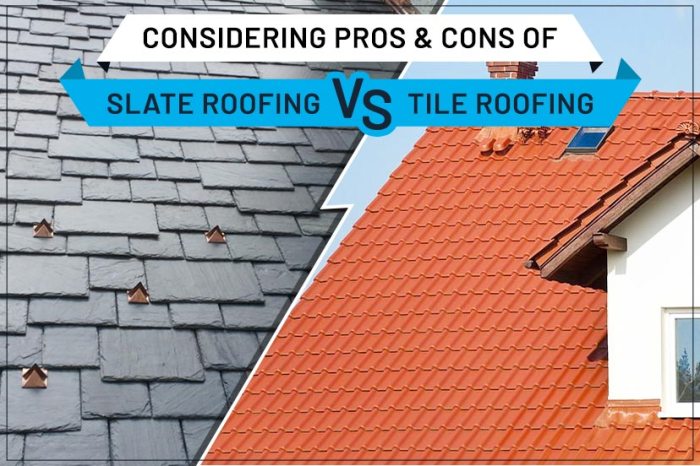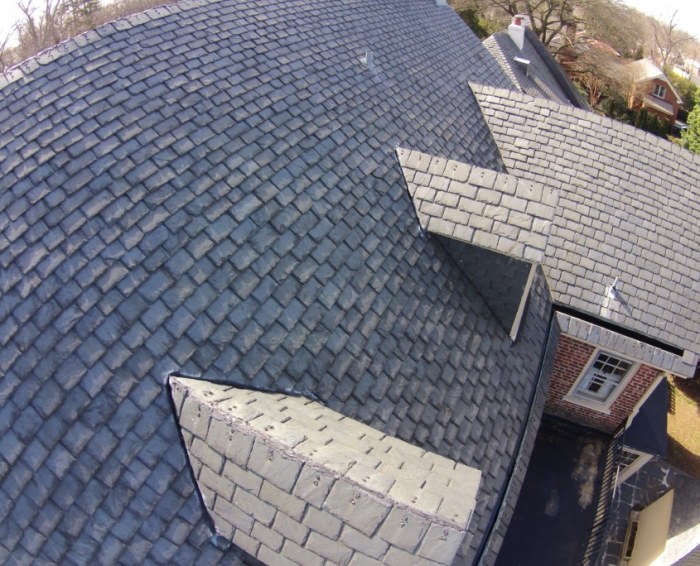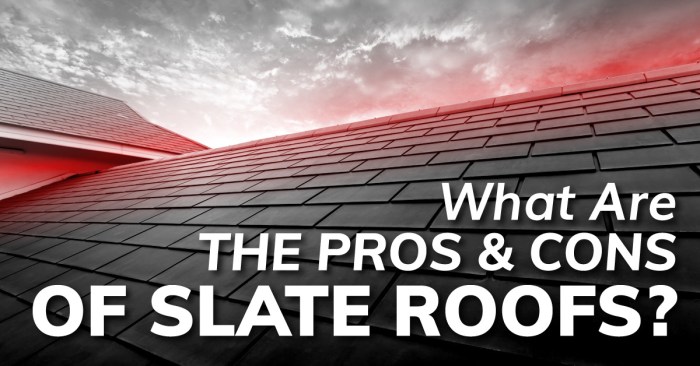Exploring the Pros and Cons of Slate Roofing

Slate roofing pros and cons offer a comprehensive look at the advantages and disadvantages of this timeless roofing material. From its unmatched durability to the challenges it may pose, this topic delves into the intricacies of choosing slate for your roof.
As we delve deeper into the details, you'll discover the key factors that make slate roofing a popular choice and the considerations that may influence your decision-making process.
Pros of Slate Roofing

Slate roofing offers numerous advantages that make it a popular choice for homeowners looking for a long-lasting and visually appealing roof.
Durability of Slate Roofing
Slate roofs are known for their exceptional durability, with a lifespan of up to 100 years or more when properly maintained. Unlike other roofing materials that may deteriorate over time, slate is resistant to harsh weather conditions, such as rain, snow, and hail, making it an excellent long-term investment for homeowners.
Aesthetic Appeal of Slate Roofs
One of the main attractions of slate roofing is its timeless beauty and elegant appearance. Slate tiles come in a variety of colors and textures, adding a touch of sophistication to any home. The natural look of slate enhances the curb appeal of a property, increasing its overall value.
Environmental Benefits of Using Slate as a Roofing Material
Slate is a natural material that is eco-friendly and sustainable, making it a green roofing option for environmentally conscious homeowners. Unlike synthetic materials, slate does not release harmful chemicals into the environment during production or disposal. Additionally, the long lifespan of slate roofs reduces the need for frequent replacements, minimizing waste and contributing to a more sustainable living environment.
Lifespan of Slate Roofs Compared to Other Roofing Materials
When comparing the lifespan of slate roofs to other roofing materials like asphalt shingles or wood shakes, slate stands out as a superior choice in terms of longevity. While asphalt shingles may last 20-30 years and wood shakes around 30-40 years, slate roofs can outlast them by several decades, providing homeowners with a cost-effective and durable roofing solution in the long run.
Cons of Slate Roofing

Installing a slate roof can come with a hefty price tag due to the high cost of materials and labor involved. However, the durability and longevity of slate roofing can often offset this initial investment over time.
Weight of Slate and Structural Implications
Slate is a heavy material, and this weight can pose structural challenges for some buildings. It is important to ensure that the existing structure of the roof can support the added weight of a slate roof. Additional reinforcement may be necessary, increasing the overall cost of installation.
Maintenance Requirements for Slate Roofs
While slate roofs are known for their longevity, they do require regular maintenance to ensure they remain in good condition. This can include replacing broken or damaged slates, repairing flashing, and keeping the roof clean of debris. Failure to properly maintain a slate roof can lead to issues such as leaks and water damage.
Common Issues and Challenges
One common issue faced with slate roofing is the potential for individual slates to break or become dislodged over time. This can be caused by severe weather conditions, improper installation, or simply the natural aging of the material. Additionally, finding an experienced roofer who is knowledgeable about working with slate can be a challenge, as it is a specialized skill set.
Types of Slate Roofing
When it comes to slate roofing, there are different types of slate materials that can be used for this purpose. Each type has its own unique characteristics and benefits.Natural Slate vs Synthetic Slate:Natural slate is a traditional roofing material that is known for its durability and natural beauty.
It is a natural stone product that is quarried from the earth. On the other hand, synthetic slate is a man-made alternative to natural slate. It is typically made from a combination of recycled materials such as rubber, plastic, and asphalt.
While synthetic slate is more affordable and easier to install, natural slate is considered to be more authentic and long-lasting.Color Variations:Slate roofing comes in a variety of colors, ranging from shades of gray and black to green, red, and purple.
The color of the slate is determined by the mineral composition of the rock from which it is quarried. Homeowners can choose the color that best complements the overall aesthetic of their home.Geographical Availability:Slate is a natural material that is quarried from various regions around the world.
Some of the most popular sources of slate for roofing include Vermont, Pennsylvania, Spain, and China. The geographical location of the slate quarry can impact the cost and availability of the material, as well as the specific characteristics of the slate itself.
Installation and Maintenance

Installing a slate roof is a meticulous process that requires skill and precision to ensure longevity and durability. The maintenance of a slate roof is crucial in preserving its beauty and functionality. Here we will delve into the details of installing and maintaining a slate roof, along with tips for extending its lifespan and the importance of hiring professional installers.
Installation of a Slate Roof
Installing a slate roof involves several steps to ensure a proper and secure fit. The process typically includes:
- Preparation of the roof deck to ensure it is stable and can support the weight of the slate tiles.
- Installation of underlayment to provide a barrier against moisture and to protect the roof deck.
- Measuring and cutting the slate tiles to fit the roof dimensions accurately.
- Securing the slate tiles in place using nails or hooks while ensuring proper overlap for water drainage.
- Finishing touches such as installing hip and ridge tiles for a polished look.
Maintenance Practices for Slate Roofing
Preserving a slate roof involves regular maintenance to prevent damage and prolong its lifespan. Some essential maintenance practices include:
- Inspecting the roof regularly for any cracked or loose tiles and repairing them promptly.
- Cleaning the roof surface to remove debris, moss, and algae that can cause water damage.
- Checking and repairing flashing around chimneys, vents, and skylights to prevent leaks.
- Trimming overhanging branches to prevent damage from falling limbs or debris.
Tips for Prolonging the Lifespan of a Slate Roof
To extend the lifespan of a slate roof, consider the following tips:
- Regularly clean and inspect the roof to address any issues promptly.
- Avoid walking on the roof to prevent damage to the slate tiles.
- Ensure proper attic ventilation to prevent moisture buildup that can damage the roof.
- Trim trees and remove debris that could potentially damage the roof during storms.
Importance of Hiring Professional Installers
It is essential to hire professional installers for slate roofing projects to ensure the job is done correctly and to avoid costly repairs in the future. Professional installers have the necessary expertise and experience to handle the complexities of slate roofing, ensuring a quality installation that will last for years to come.
Wrap-Up
In conclusion, the discussion on slate roofing pros and cons sheds light on the various aspects to consider when opting for this elegant roofing solution. Whether you prioritize longevity or weigh the costs, understanding these factors can help you make an informed choice for your home.
FAQ Overview
What is the average lifespan of a slate roof?
The average lifespan of a slate roof ranges from 75 to 200 years, far surpassing many other roofing materials.
Are there color variations available in slate roofing?
Yes, slate roofing comes in a variety of colors including gray, green, purple, and red, adding to its aesthetic appeal.
How important is it to hire professional installers for slate roofing projects?
Hiring professional installers is crucial for slate roofing projects to ensure proper installation and maximize the longevity of the roof.

